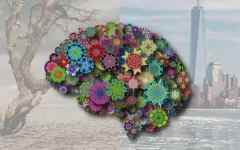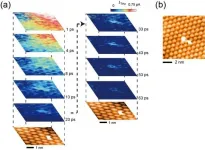INFORMATION:
Alpha particles lurk at the surface of neutron-rich nuclei
2021-01-21
(Press-News.org) Scientists from an international collaboration have found evidence of alpha particles at the surface of neutron-rich heavy nuclei, providing new insights into the structure of neutron stars, as well as the process of alpha decay.
Neutron stars are amongst the most mysterious objects in our universe. They contain extremely dense matter that is radically different from the ordinary matter surrounding us--being composed almost entirely of neutrons rather than atoms. However, in the nucleus at the center of normal atoms, matter exists at similar densities.
"Understanding the nature of matter at such extremes is important for our understanding of neutron stars, as well as the beginning, workings, and final fate of the universe," says Junki Tanaka, one of the leaders of the study.
"Intriguingly, despite the vast difference in size and mass, the tiny atomic nuclei found on Earth and the enigmatic neutron star are actually governed by the same type of interactions," says Zaihong Yang, also a co-corresponding author of the paper. This connection has been well established by scientists through the nuclear equation of state (EOS) which describes the relation between the density and the pressure of nuclear matter.
In the current finding, published in Science, the research team led by scientists from the RIKEN Nishina Center for Accelerator-Based Science, TU Darmstadt, and the Research Center for Nuclear Physics (RCNP) examined tin nuclei, and found evidence of "alpha clusters"--groups of two protons and two neutrons--in heavy nuclei.
For the experiments, the group examined a series of neutron-rich isotopes of tin ranging from tin 112, which has only 62 neutrons, to tin 124, which has 74 neutrons and thus has a much thicker neutron-skin. They used a method to deliberately knock out alpha particles from the nuclei by bombarding them with protons at the Research Center for Nuclear Physics (RCNP) at Osaka University, and then examined how frequently they were able to observe alpha particles in progressively heavier isotopes.
They identified the clusters in the very surface region of neutron-rich tin atomic nuclei, implying that the so-called "neutron skin" is not purely neutron matter as its name implies, but also includes alpha clusters. Importantly, they also discovered that "the effective number of alpha clusters"--the probability of finding alpha clusters in nuclei--decreased gradually along with the number of neutrons, and theorized that this is due to the interplay between alpha cluster formation and the thickness of the "neutron skin" that surrounds the nucleus.
This finding has important implications for our understanding of nuclear EOS and neutron stars. In the near future, more and more accurate data on the bulk properties--mass and radius--of neutron stars will be available from electromagnetic and gravitational-wave observations.
The present work is also a key step towards a full understanding of alpha decay--a type of radioactive decay in which an atomic nucleus spontaneously emits an alpha particle. About 90 years ago, physicist George Gamow famously proposed that alpha decay takes place due to the quantum tunneling of preformed alpha particles or clusters. However, though the theory was generally accepted, it was never shown conclusively that such clusters actually existed in heavy atoms.
The finding of the current work that alpha clusters exist at the surface of heavy nuclei could provide an answer to the question about the origin of alpha particles in alpha decay. In the future, the group plans to work with high-energy accelerators such as the RI Beam Factory at RIKEN and GSI/FAIR, a new accelerator facility being built in Germany to do studies using alpha-radioactive isotopes.
ELSE PRESS RELEASES FROM THIS DATE:
COVID-19 is dangerous for middle-aged adults, not just the elderly
2021-01-21
COVID-19 has been spreading rapidly over the past several months, and the U.S. death toll has now reached 400,000. As evident from the age distribution of those fatalities, COVID-19 is dangerous not only for the elderly but for middle-aged adults, according to a Dartmouth-led study published in the European Journal of Epidemiology.
"For a person who is middle-aged, the risk of dying from COVID-19 is about 100 times greater than dying from an automobile accident," explains lead author Andrew Levin, a professor of economics at Dartmouth College. "Generally speaking, very few children and young adults die of COVID-19. However, the risk is progressively greater for middle-aged and older adults. The odds that ...
Researchers make domestic high-performance bipolar membranes possible
2021-01-21
The bipolar membrane, a type of ion exchange membrane, is considered the pivotal material for zero emission technology. It is composed of an anode and cathode membrane layer, and an intermediate hydrolysis layer. Under reverse bias, the water molecules in the intermediate layer produce OH- and H+ by polarization.
Large-scale production of the membrane is hindered by the different expansion coefficients of the anode and cathode layers, causing the two layers easy to delaminate. Besides, the mostly used intermediate catalysts are small molecules or transition, which are instable and inefficient.
In a study published on Nature Communications, a team led by ...
Does aspirin lower colorectal cancer risk in older adults? It depends on when they start.
2021-01-21
BOSTON - Regular aspirin use has clear benefits in reducing colorectal cancer incidence among middle-aged adults, but also comes with some risk, such as gastrointestinal bleeding. And when should adults start taking regular aspirin and for how long?
There is substantial evidence that a daily aspirin can reduce risk of colorectal cancer in adults up to age 70. But until now there was little evidence about whether older adults should start taking aspirin.
A team of scientists set out to study this question. They were led by Andrew T. Chan MD, MPH, a gastroenterologist and chief of the Clinical and Translational Epidemiology Unit at Massachusetts General Hospital (MGH). Their report appears in JAMA Oncology.
The researchers ...
How the brain learns that earmuffs are not valuable at the beach
2021-01-21
Tsukuba, Japan -- How valuable are earmuffs? The answer to this simple question can depend. What brand are they? Are they good quality? What is the weather like? Given the choice between earmuffs and suntan lotion, most people would choose to have the earmuffs on a cold winter day and the lotion on a sunny day at the beach. This ability to place different values on objects depending on the environmental context is something that we do all the time without much thought or effort. But how does it work? A new study led by Assistant Professor Jun Kunimatsu at the University of Tsukuba in Japan and Distinguished Investigator Okihide Hikosaka at the National Eye Institute (NEI) in the United States has discovered the part of ...
Search for axions from nearby star Betelgeuse comes up empty
2021-01-21
The elusive axion particle is many times lighter than an electron, with properties that barely make an impression on ordinary matter. As such, the ghost-like particle is a leading contender as a component of dark matter -- a hypothetical, invisible type of matter that is thought to make up 85 percent of the mass in the universe.
Axions have so far evaded detection. Physicists predict that if they do exist, they must be produced within extreme environments, such as the cores of stars at the precipice of a supernova. When these stars spew axions out into the universe, the ...
Electrons caught in the act
2021-01-21
Tsukuba, Japan - A team of researchers from the Faculty of Pure and Applied Sciences at the University of Tsukuba filmed the ultrafast motion of electrons with sub-nanoscale spatial resolution. This work provides a powerful tool for studying the operation of semiconductor devices, which can lead to more efficient electronic devices.
The ability to construct ever smaller and faster smartphones and computer chips depends on the ability of semiconductor manufacturers to understand how the electrons that carry information are affected by defects. However, these motions occur on the scale of trillionths of a second, and they can only be seen with a microscope that can image individual atoms. ...
Study results show COVID-19 virus triggers antibodies from previous coronavirus infections
2021-01-21
The results of a study led by Northern Arizona University and the Translational Genomics Research Institute (TGen), an affiliate of City of Hope, suggest the immune systems of people infected with COVID-19 may rely on antibodies created during infections from earlier coronaviruses to help fight the disease.
COVID-19 isn't humanity's first encounter with a coronavirus, so named because of the corona, or crown-like, protein spikes on their surface. Before SARS-CoV-2 -- the virus that causes COVID-19 -- humans have navigated at least 6 other types of coronaviruses.
The study sought to understand how coronaviruses (CoVs) ignite the human immune system and conduct a deeper ...
Tough childhood damages life prospects
2021-01-21
An adverse upbringing often impairs people's circumstances and health in their adult years, especially for couples who have both had similar experiences. This is shown by a new study, carried out by Uppsala University researchers, in which 818 mothers and their partners filled in a questionnaire one year after having a child together. The study is now published in the scientific journal PLOS ONE.
"When we studied couples where both partners stated they'd had a hard time as children, the connection between negative childhood experience and a relatively ...
Burial practices point to an interconnected early Medieval Europe
2021-01-21
Early Medieval Europe is frequently viewed as a time of cultural stagnation, often given the misnomer of the 'Dark Ages'. However, analysis has revealed new ideas could spread rapidly as communities were interconnected, creating a surprisingly unified culture in Europe.
Dr Emma Brownlee, Department of Archaeology, University of Cambridge, examined how a key change in Western European burial practices spread across the continent faster than previously believed - between the 6th - 8th centuries AD, burying people with regionally specific grave goods was largely abandoned in favour of a more standardised, unfurnished burial.
"Almost everyone from the eighth century onwards ...
When it comes to eyewitness accounts of earthquake shaking, representation matters
2021-01-21
As scientists increasingly rely on eyewitness accounts of earthquake shaking reported through online systems, they should consider whether those accounts are societally and spatially representative for an event, according to a new paper published in Seismological Research Letters.
Socioeconomic factors can play a significant if complex role in limiting who uses systems such as the U.S. Geological Survey's "Did You Feel It?" (DYFI) to report earthquake shaking. In California, for instance, researchers concluded that DYFI appears to gather data across a wide socioeconomic range, albeit with some intriguing differences related to neighborhood income levels during earthquakes such as the ...


